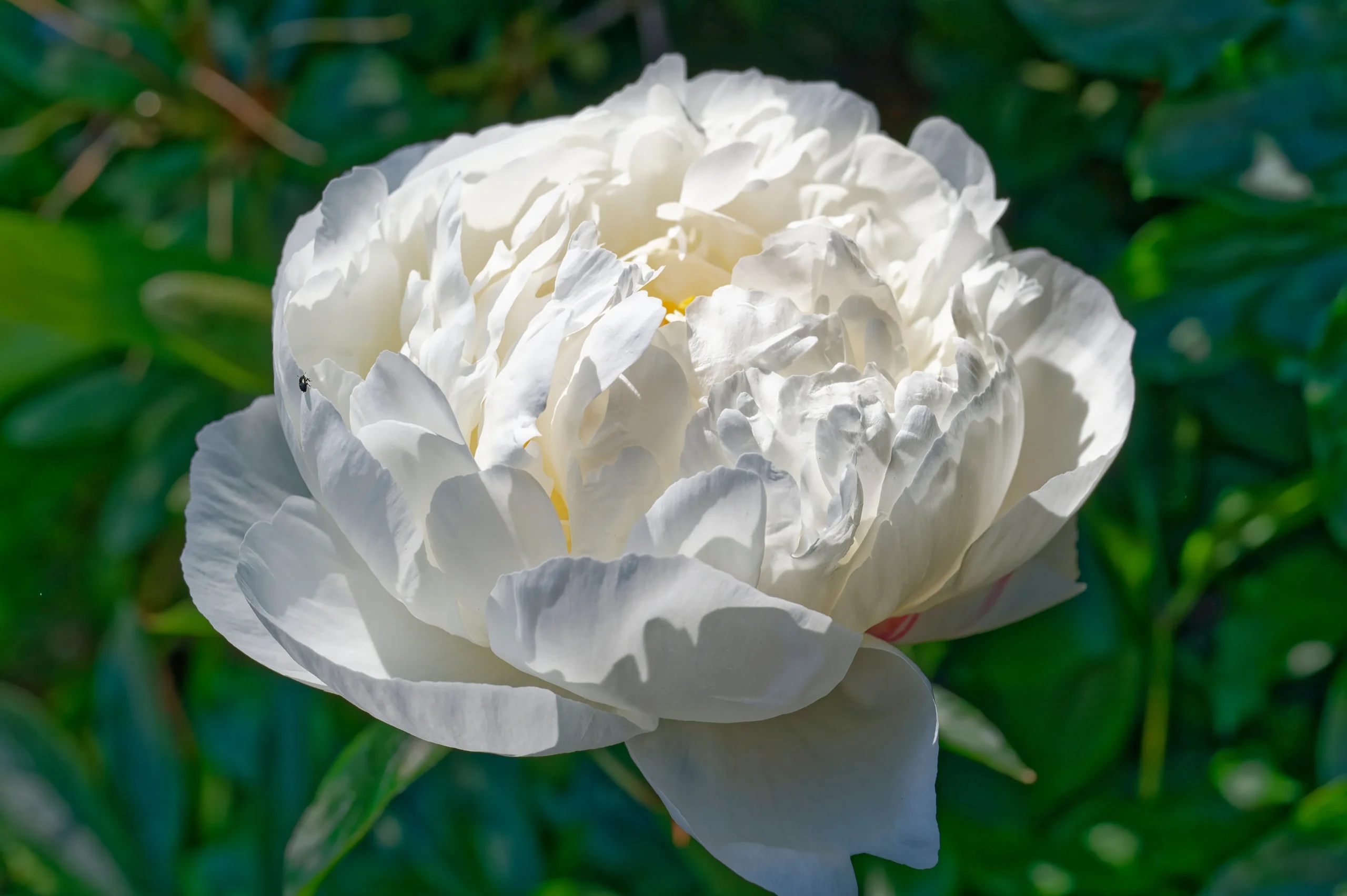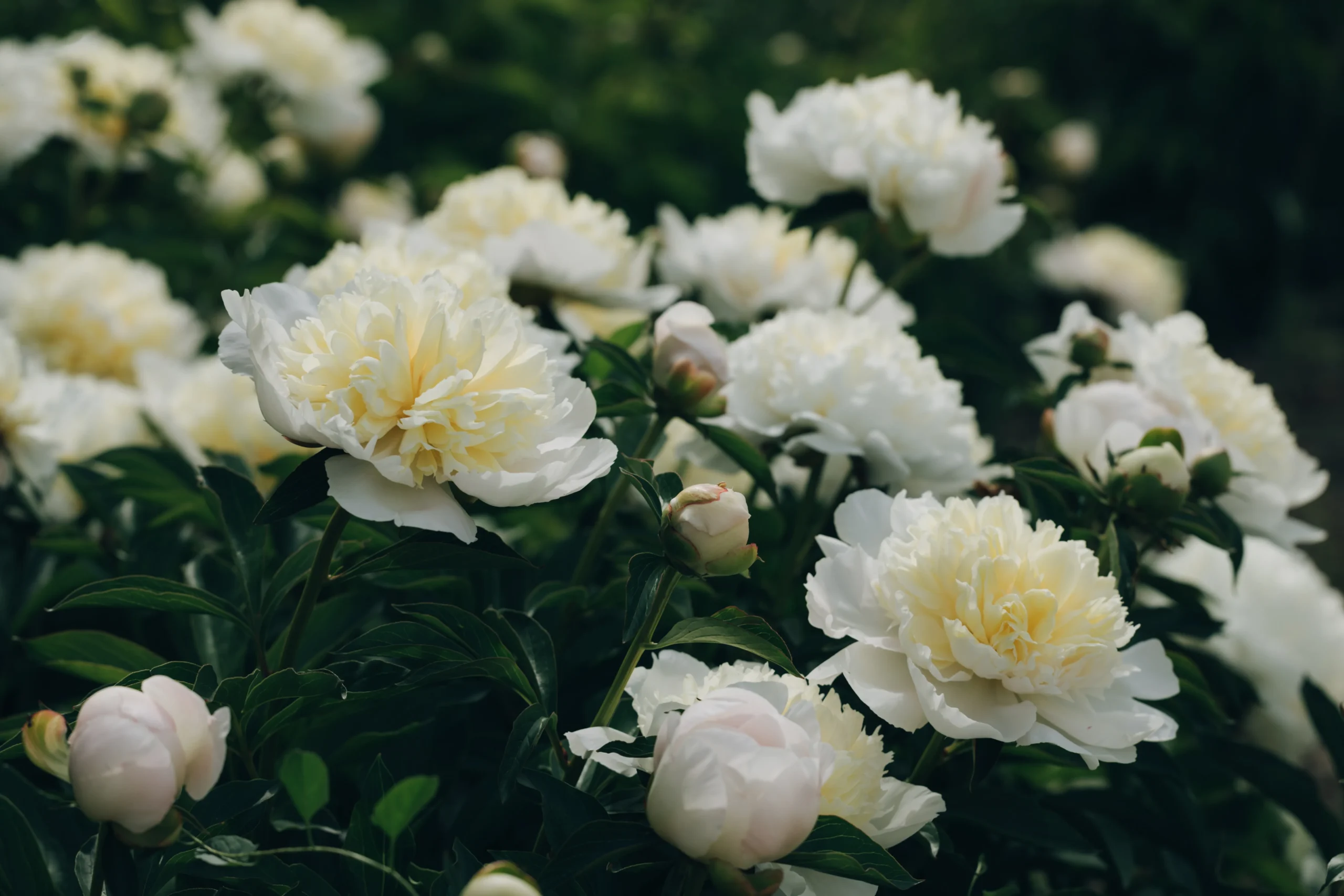Family: Peony
Type: Perennial

The Duchesse De Nemours Peony is a classic beauty that graces gardens with its stunning, fragrant blooms. This heirloom variety, cherished since the mid-19th century, offers lush, double white flowers with a hint of cream at the base of the petals. Its sweet scent and elegant appearance make it a favorite among gardeners and floral enthusiasts alike.
Thriving in zones 3 through 8, this peony variety demands little but rewards greatly. It prefers full sun to partial shade and well-drained soil, showcasing its blooms in late spring to early summer. The Duchesse De Nemours Peony reaches up to 2 to 3 feet in height and spread, making it an ideal size for many garden settings.
This peony’s timeless elegance and robust growth habit ensure it remains a popular choice for both traditional and contemporary gardens. Whether planted in mass groupings or as a solitary specimen, the Duchesse De Nemours Peony adds a touch of sophistication and charm to any outdoor space.
Hardiness Zone: 2a-8a
Deer Resistant: Yes
Pet Friendly: Yes
Moisture Preference: Average to moist
Sun Needs: Full sun
Growth Rate: Slow
Average Height (feet): 3
Average Spread (feet): 3
Average Life Span (years): 20
Form: Round
Flower Color: White
Secondary Flower Color: Yellow
Bloom Season: From late spring to early summer
Foliage Color: Green
Incorporating Duchesse De Nemours Peonies into your landscape design offers a breathtaking display of blooms each spring. Their classic beauty enhances garden beds, borders, and foundation plantings with ease. These peonies act as stunning focal points when in bloom, drawing the eye with their elegant flowers and lush foliage.
Companion planting can further highlight the Duchesse De Nemours Peony’s beauty. Consider pairing them with low-growing perennials and annuals that complement their height and color. This not only adds depth and interest to your garden but also helps to frame and accentuate the peonies’ dramatic blooms.
Beyond their blooming period, Duchesse De Nemours Peonies provide structured green foliage that remains attractive throughout the summer. Their leaves turn a subtle bronze in the fall, offering extended visual interest well beyond their flowering season. This makes them valuable additions to any garden looking for multi-season appeal.

The Duchesse De Nemours Peony is perfectly at home in the cottage garden style. Its romantic blooms and rich fragrance contribute to the relaxed, abundant feel characteristic of cottage gardens. Mixing peonies with other perennials and annuals creates a charming, informal display that's both beautiful and bountiful.
In formal garden settings, the Duchesse De Nemours Peony shines as a specimen of pure elegance and symmetry. Its structured growth and impressive blooms lend themselves well to formal designs, including parterres and borders. Their classic white flowers add a sense of luxury and timelessness to formal landscapes.
While not a traditional woodland plant, the Duchesse De Nemours Peony can adapt to the dappled shade of a woodland garden. Here, it offers a bright spot of light among darker foliage, creating a stunning contrast. This setting emphasizes the peony's natural beauty and brings a touch of refinement to the woodland garden.
The versatility of the Duchesse De Nemours Peony means it can be used in a variety of landscaping themes. Plant them along walkways or entryways where their fragrance can be fully appreciated. This not only welcomes visitors but also creates an enchanting walk-through experience.
Mass planting these peonies creates an unforgettable sight when they bloom in unison. Their uniform color and height can act as an elegant backdrop for lower-growing flowers or as a stunning border that defines garden spaces. Such a display is especially impactful in formal garden settings or as a feature in large, open areas.
For a more relaxed look, mix Duchesse De Nemours Peonies with a variety of perennials of differing textures and colors. This approach creates a dynamic, layered effect that highlights the peony’s elegance while fostering biodiversity. The peony’s foliage continues to provide interest even after the blooms have faded, making it a valuable garden component year-round.
Select our pre-made garden layouts to create a landscape that’s uniquely yours. Simple, smart, and customizable!
In spring, the Duchesse De Nemours Peony steals the show with its lush, double white blooms. The garden comes to life as these flowers open, revealing their creamy centers and filling the air with their sweet fragrance. This is the peony's moment to shine, setting the tone for the blooming season.
After the blooms have faded, the Duchesse De Nemours Peony's deep green foliage continues to add texture and depth to the summer garden. Its robust leaves stand strong throughout the season, providing a lush, green backdrop for summer-flowering plants.
As autumn arrives, the foliage of Duchesse De Nemours Peonies takes on a bronze hue, adding a new layer of color to the fall garden. This subtle change complements the season's palette, offering visual interest even as the garden begins to wind down for the year.
In winter, the Duchesse De Nemours Peony retreats below the ground, lying dormant until the next spring. While the plant itself is not visible, its presence is marked by the anticipation of the stunning display to come. This cycle of renewal is a reminder of the enduring beauty and resilience of peonies in the garden.
Choose a sunny spot with well-drained soil for your Duchesse De Nemours Peony. Avoid areas that become waterlogged or are in deep shade, as this can affect blooming and overall health. A location that receives morning sun and afternoon shade is ideal, especially in hotter climates.
Duchesse De Nemours Peonies perform best in full sun to partial shade. They need at least six hours of sunlight to bloom well. In regions with very hot summers, providing some afternoon shade can help protect the blooms and foliage from scorching.
Well-drained, fertile soil with a neutral to slightly acidic pH is perfect for Duchesse De Nemours Peonies. They can tolerate a range of soil types, but good drainage is crucial to prevent root rot. Incorporating organic matter into the soil can improve its quality and support healthy growth.
Space plants about 2 to 3 feet apart to ensure adequate air circulation and room for growth. Proper spacing prevents overcrowding, reduces competition for nutrients and water, and minimizes the risk of fungal diseases.
Plant Duchesse De Nemours Peonies in the fall, about six weeks before the ground freezes. This allows the roots to establish before winter. In warmer climates, planting in late fall or early winter is also successful.
Dig a hole large enough to accommodate the root ball, with room to spread. Set the plant so the eyes (buds) are no more than 2 inches below the soil surface. Backfill with soil, water thoroughly, and apply a layer of mulch to conserve moisture and regulate soil temperature.
Water regularly to keep the soil moist, especially during dry spells and when the plant is establishing. Once established, Duchesse De Nemours Peonies are quite drought-tolerant. Avoid overhead watering to reduce the risk of leaf spot diseases.
Apply a balanced, slow-release fertilizer in early spring as new growth appears. Avoid high-nitrogen fertilizers, which can promote leaf growth at the expense of blooms. A top dressing of compost can also provide necessary nutrients.
After flowering, remove spent blooms to maintain a tidy appearance. In fall, after the foliage dies back, cut the stems down to ground level. This helps prevent overwintering pests and diseases.
Remove winter mulch and any debris from around the plants. Apply fertilizer and mulch to conserve moisture and suppress weeds. Support stems with stakes or rings if needed, as the large blooms can become heavy.
Water peonies during prolonged dry periods, especially if you notice wilting. Continue to monitor for pests and diseases, treating as necessary.
Cut back foliage to ground level after it dies back. Apply a light layer of mulch for winter protection, especially in areas with harsh winters.
In colder zones, ensure your peonies are well-mulched to protect against freeze-thaw cycles that can heave roots out of the ground. In milder climates, little winter care is needed.
With proper care, Duchesse De Nemours Peonies can live for decades, often outliving the gardeners who plant them. They are known to thrive for 50 years or more.
While it’s possible, peonies generally perform best in the ground. If you choose to grow them in containers, ensure the pot is large enough to accommodate their deep root system and provide adequate drainage.
Peonies are relatively pest-resistant. However, they can attract ants due to the nectar that coats their buds. Ants are beneficial and help to protect the buds from other pests, so there’s no need to remove them.
Sign up below to get exclusive deals, discounts, and new plant collections—delivered straight to your inbox! Plus, stay inspired with the latest gardening tips, landscaping trends, and DIY garden ideas. Start growing with us today!
A big thank you for subscribing to the PBN Design newsletter.
We're thrilled to have you join our community. Get ready for exciting updates, insightful content, and more delivered straight to your inbox.
Stay tuned!
Go backA big thank you for subscribing to the PBN Design newsletter.
We're thrilled to have you join our community. Get ready for exciting updates, insightful content, and more delivered straight to your inbox.
Stay tuned!
Go back